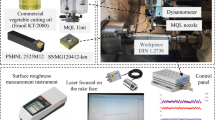Abstract
Numerical control milling (NCM) at high speed is the most used machining process in the manufacture of molds because it offers high productivity and workpiece surface quality. The aim of this work is to establish a methodology to evaluate the rough machining time, during high speed milling. In pocket machining, a 2.5D milling has been considered. The proposed approach considers the roughing cutting time as the ratio of the pocket volume by the removed material rate. The pocket is divided into volumes distributed according to the real radial depth. Since the radial depth varies during machining, the removed material rate is not constant. In this paper, an experimental study is carried out to validate models of machining time calculation. The obtained results show that the proposed method offers fast and easy calculation of the machining time of pocket roughing.
Similar content being viewed by others
References
Kim K-K, Krang M-C, Kim J-S, Jury Y-H, Kim NK (2002) A study on the precision machinability of ball end milling by cutting speed optimization. J Mater Process Technol 130:357–362
Lee CM, Kim SW, Lee YH, Lee DW (2004) The optimal cutter orientation in ball end milling of cantilever-shaped thin plate. J Mater Process Technol 153–154:900–906
Tang Y (2006) Optimization strategy in end milling process for high speed machining of hardened die/mold steel. Journal of University of Science and Technology Beijing, Mineral, Metallurgie, Material 13:240–243
Monreal M, Rodriguez CA (2003) Influence of tool path strategy on the cycle time of high-speed milling. Comput-Aided Des 35:395–401
Hinduja S, Roady A, Philimis P, Barrow G (2001) Determination of optimum cutter diamter for machining 2, 5 D pockets. Int J Mach Tools Manuf 41:687–702
Othmani R, Bouzid W, Hbaieb M (2008) Machining time in rough milling. Mater Technol Adv Perform Mater 23:169–173
Pateloup V, Duc E, Ray P (2004) Corner optimisation for pocket machining. Int J Mach Tools Manuf 44:1343–1353
Hsiao F, Xu S, Lin C, Tsai Z (2008) Robustness design of fuzzy control for nonlinear multiple time delay large scale systems via neural based approach. IEEE Trans Syst Man Cybern B Cybern 38:1
Chen CY, Hsu JRC, Chen CW (2005) Fuzzy logic derivation of neural network models with time delays in subsystems. Int J Artif Intell Tools 14:967–974
Goupy J (2005) Pratiquer les plans d’expériences. Dunod EAN13:9782100042173
Poulachon G, Dessoly M, Le Calvez C, Lebrun JL, Prunet V, Jawahir IS (2001) An investigation of the influence of sulphide inclusions on tool-wear in high speed milling of tool steels. Wear 250:334–343
Author information
Authors and Affiliations
Corresponding author
Rights and permissions
About this article
Cite this article
Hbaieb, M., Othmani, R. & Bouzid, W. Time modeling in high-speed machining of mold pocket. Int J Adv Manuf Technol 53, 113–120 (2011). https://doi.org/10.1007/s00170-010-2844-7
Received:
Accepted:
Published:
Issue Date:
DOI: https://doi.org/10.1007/s00170-010-2844-7




